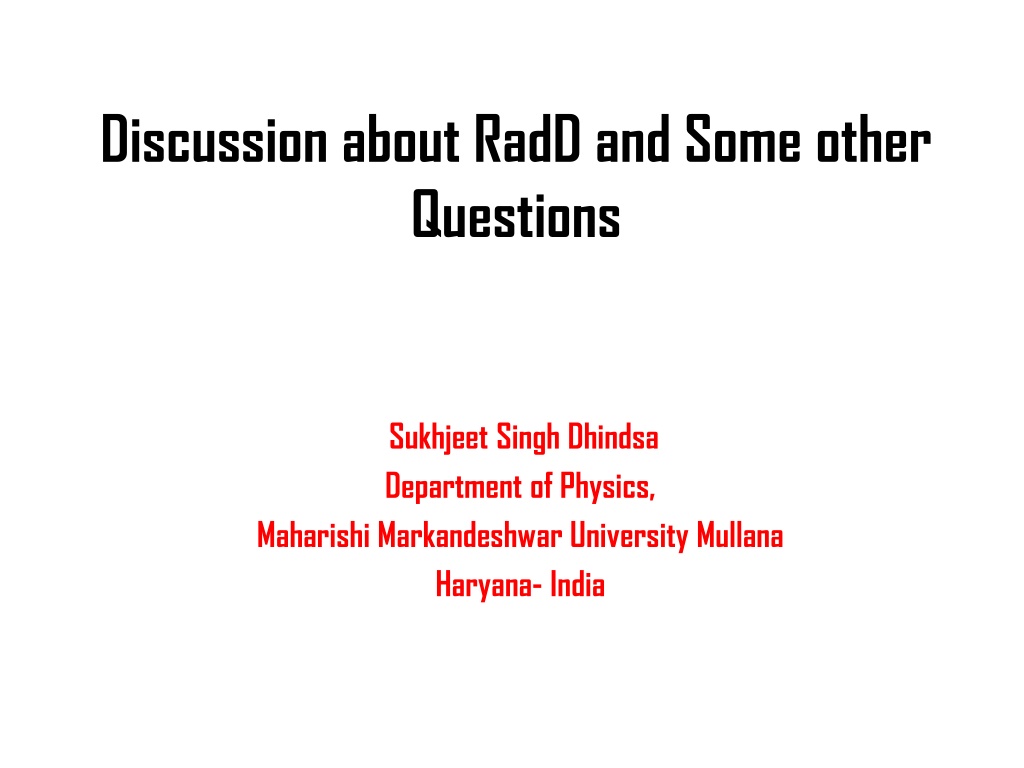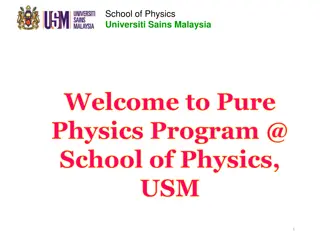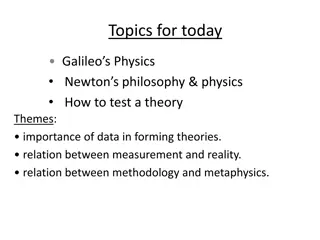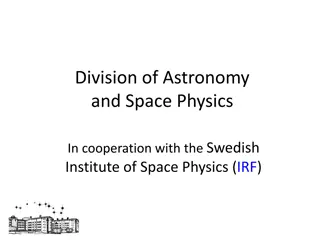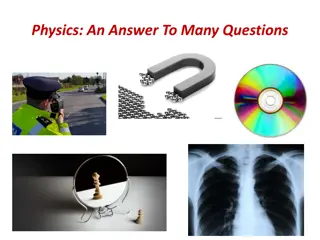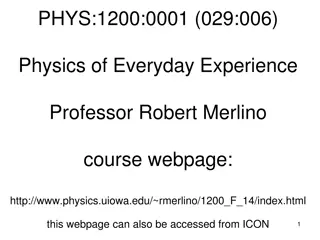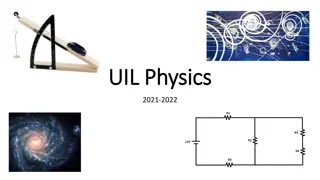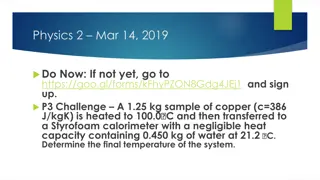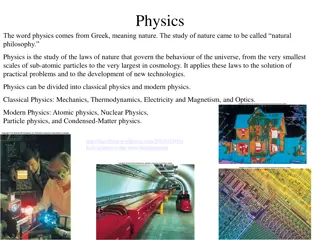Discussion on RadD and Other Questions in Physics
This discussion revolves around suggestions for improvements in the RadD code related to Physics, such as providing a Makefile, combining data structures, simplifying user input, and considering interpolation techniques. The conversation also addresses changes in the ALPHAD program for calculating hindrance factors and theoretical half-lives. Various experts share their insights and recommendations to enhance the code functionalities effectively.
Download Presentation

Please find below an Image/Link to download the presentation.
The content on the website is provided AS IS for your information and personal use only. It may not be sold, licensed, or shared on other websites without obtaining consent from the author.If you encounter any issues during the download, it is possible that the publisher has removed the file from their server.
You are allowed to download the files provided on this website for personal or commercial use, subject to the condition that they are used lawfully. All files are the property of their respective owners.
The content on the website is provided AS IS for your information and personal use only. It may not be sold, licensed, or shared on other websites without obtaining consent from the author.
E N D
Presentation Transcript
Discussion about RadD and Some other Questions Sukhjeet Singh Dhindsa Department of Physics, Maharishi Markandeshwar University Mullana Haryana- India
Comments and Suggestions for New Code: RadD Comment by F.Kondev It would be useful that the developers provide a Makefile (for Unix based computers) the way a code needs to be compiled Our Response We prepared Makefile for this code and it is working successfully. But I guess Makefile is very useful if there are too many programs or too many commands are required to be executed for desired output. But in present case only one or two commands are required.
Comments cont Comment by Dr. F.Kondev It may be useful to combine ELE.in as a data structure in a subroutine, rather than reading the file separately. Same could be applied to the 98Ak04.in data file. Both should be easy to implement Our Response We have successfully combined ELE.in and 98Ak04 in a data structure statement within the source code (RadD.for).
Comment by Dr. F.Kondev It would be much easier from the user point of view on input to ask only for the parent nuclide, in a free format line 208PB, 208Pb, 208pb,PB208, Pb208 or pb208, and then the program should figure out what is N,Z for the parent and daughter - this should be easy to implement. Comment by Dr. Balraj Singh Also as I mentioned earlier if possible it would be better to enter daughter A value and symbol for element: e.g for 195Bi alpha decay to 191Tl, one should be able to enter A=191, element symbol TL; now one needs to do a bit of arithmetic before entering data. You already have a table of element symbols for identification, but of the course the code needs to change to recognize relate symbols to Z value and calculate N=A-Z. Our Response Since it is the daughter nucleus for which radius parameter is being calculated by this code. So, I think it will be good to enter daughter A value and symbol (as suggested by Dr. Balraj Singh) but with free format (as suggested by Dr. F. Kondev), otherwise one have to do little arithmetic before entering the numbers.
Interpolation ? Is it reliable to use some interpolation techniques to deduce the missing ro values ? Newton s Interpolation , Langrange s Interpolation etc
Steps for Changes in ALPHAD Code The existing ALPHAD program reads an ENSDF-formatted file and produces a report of the hindrance factors, theoretical half-lives, and R0's calculated by the program. We specify R0 on an ALPHA comment record by HF in columns 10 and 11 and a dollar sign ( $ ) in column 12 or blanks in columns 12 through 19. The first value and uncertainty in columns 20 through 80 preceded by an R ( R case insensitive) and an equal sign ( = ) or approximate sign ( AP ) will be taken as R0. I should insert Table 1-IV (radius parameters for odd-even,even-odd, odd-odd and even-even) in existing program as a data structure . When this code reads the given ENSDF, It should identify Z and N of the alpha daughter nuclei and choose the appropriate radius parameter from above data structures It should follows the same route as earlier ALPHAD code
Existing Policy Is it possible to assign a key number to set 1 (Writeup + Table I, Table II and Table III) of our RadD package and put that key number in existing policy as: For odd-A and odd-odd nuclei the radius parameters (new key number) are deduced by taking average of radii for adjacent even even nuclei (1998Ak04)
Status of Magnetic Rotational Band Compilation Updates for existing systems listed in Table of MR bands, Dec. 2006 Nuclide Ref Updates in the form of 82Rb 2009Yu10 83Rb 103Ag 2009Sc22 2008Ra06 Extension up to higher spin values. Observation of new band(s) g factor and life time measurements Confirmation of spin parity assignments Some theoretical papers also appeared after Dec. 2006, which which confirm earlier configuration assignments, band crossing and spin parity assignments. 139Sm 2008Pa36 193Pb 2011Ba02 194Pb 198Bi 113In 108Cd 2009Ku03 2014Pa53 2012Ma18 2010Ro15
New MR bands appeared after Dec. 20, 2006 Nuclide Reference 58Fe 60Ni 85Sr 86Y 2009RU03 106Ag 107Ag 107 Cd 107In 109In 112In Brief Details 2012St06 2008To15 2014Ku19 2013Li33 02 bands (8 - 12) and (8 - 15) 04 bands (9- - 15-), (11+ - 17+), (11+ - 17+) and (9- - 13-) 01 band (21/2+ - 31/2+) 01 band (11- - 21-) 2010He05 2014Ya02 2015Ch05 2010Ne05 2012Ne03 2012Tr11 2011He04 2009Li66 2012Li38 01 band (12+ - 22+) 02 bands(21/2+ - 37/2+) and (19/2- - 33/2-) 01 bands (31/2- - 49/2-) 01 band (19/2- - 39/2-) 01 band (19/2- - 33/2-) 01 band (8+ - 19+) 114In 01 band (11+ - 16+)
New MR bands appeared after Dec. 20, 2006 Nuclide Reference 132La Remarks 2013Ku07 They conflict with earlier assigned MR bands by Acta Phys. Pol. B 40, 647, 2009 and suggest they are not the MR bands 01 band (15- - 22-) Total 02 bands (25/2- - 37/2-) and (35/2- - 47/2-) The energy ordering of Gamma rays reported in 2009Dh01 is different from 2012ZH47, 2010Zh12 01 band (16- - 22-) 02 bands (41/2- - 51/2-) and (35/2+ - 47/2+) 01 band (16+ - 19+) 02 bands (15- - 25-), (13- - 21-) 138Ce 139Pm 2009Bh04 2012ZH47 2010Zh12 2009Dh01 2014Ra03 2014Ra18 2014Ch22 2010Pr04 2009Su09 2012Pa16 2015Au01 20008Ha39 142Sm 143Eu 144Tb 144Dy 194Tl 201At 204At 01 band (16- - 21- ) 01 band (23/2- - 37/2-) 01 band without confirmed spin and parity Total 28 new MR Bands in 21 new systems Total 178 MR Bands in 76 nuclides available in earlier compilation Dec. 2006
Literature Issues Access of secondary references is the main problem. Is it possible to get ALL the secondary reports required for a given mass chain either from NNDC or from any other source? Is it possible that an evaluator may submit all the secondary reports (used for a particular mass chain) to NNDC, so that next evaluator of that mass chain may get folder containing secondary reports used by previous evaluator.
Status of A=226 Mass Chain There are total 10 nuclides in this mass chain and 8 out of which have been checked and updated. The literature upto March 31, 2015 has been consulted. For remaining two nuclides, namely Ra and Th, the old entries have been checked but three new data sets one for Ra and two for Th are yet to be included in main ENSDF.
Comments and Suggestions from evaluators on the improvement of input database Comment by F.Kondev Akovali work is 17 years old and many new data, especially for proton-rich and heavy nuclei, are available for even-even nuclei. It would be very useful if a search on ensdf and xundl is made for even-even nuclei looking for the HF$ where the r0 is available for favored decay (e.g. HF=1.0) and compile the corresponding r0 values. One my enforce at the same time that hindrance factor of 1.0 appears on the A record for the favored decay - this should be not very difficult to implement Is it possible to do above search through Nudat or we have to scan all the even-even nuclei individually to compile above mentioned even-even radii or we have to write a code to extract required ro values from ENSDFs and XUNDLs.
